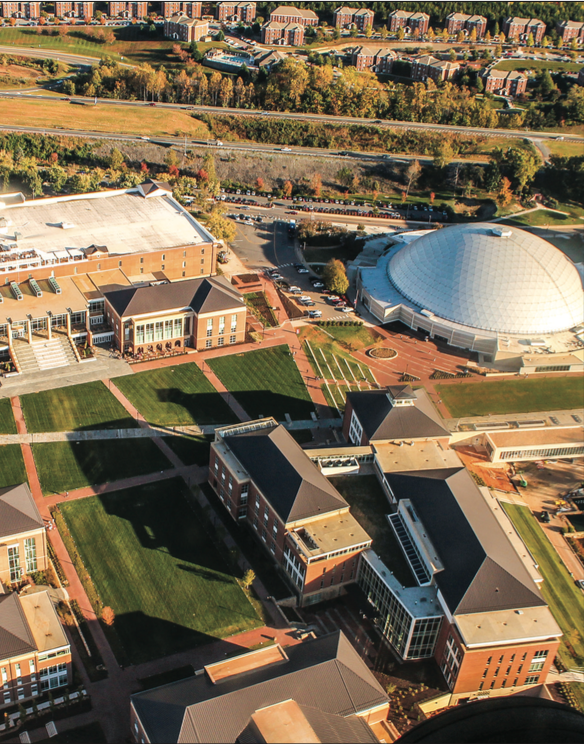Report details LU’s economic influence
A recent independent study revealed that Liberty University has become the largest and most diverse driver of economic growth in Virginia through its exponential rise in enrollment in the past 25 years.
According to the report — released last December by Mangum Economic Consulting, LLC — Liberty’s total enrollment grew from 8,500 students in Fall 1992 to 80,494 total students in Fall 2015, an increase of 847 percent, thus making it the fastest growing postsecondary institution in Virginia from 1992-2015.

GROWTH — Liberty University’s student enrollment grew by 847 percent in the past 25 years, resulting in a larger local economic impact.
Photo Credit: Amber Tiller
The report compared Liberty’s rise in enrollment to other postsecondary schools in Virginia, revealing enrollment grew by an average of 33 percent for other private non-profit colleges while four-year public universities grew by 31 percent in the past 25 years.
The result, according to Mangum Economics founder and owner Fletcher Mangum, is an unparalleled amount of economic impact that Liberty has on the Greater Lynchburg region.
“Because of its (student enrollment), Liberty’s footprint within the region continues to grow,” Mangum said.
“And the footprint the university has in terms of other economic entities continues to grow, which very clearly indicates that Liberty is the economic driver for the Greater Lynchburg area.”
In terms of fiscal impact, the report also found that Liberty generated approximately $8.8 million of tax revenue for Lynchburg City and nearly $14.5 million of tax revenue for Lynchburg and its surrounding counties of Campbell, Bedford, Appomattox and Amherst in fiscal year 2014-15.
Furthermore, the report indicates that Liberty spent nearly $593 million in the Greater Lynchburg area for the 2014-15 academic year.
This amount includes payments for local goods and services, salaries and wages, construction and equipment, and the total amount of student spending within the region.
Liberty’s local spending helped support local businesses and contractors more than any other institution in Lynchburg, the report concluded.
Its expenditures within the region generated nearly $1.1 billion of economic activity, which is the total amount of money accumulated within the Greater Lynchburg area after calculating all direct and indirect expenditures.
Indirect expenditures include payments an employee of Liberty may make to businesses in the Lynchburg area.
When a Liberty employee uses his or her salary to purchase a good or service produced within Lynchburg, then Liberty benefits the region both directly through salary payments and indirectly through the local purchases an employee makes with his or her salary.
Mangum said his firm uses a model called the IMPLAN model to calculate how much indirect expenditures are made through Liberty’s direct expenditures.
The model uses industry and region- specific data to calculate how much of the money Liberty spends stays within the Lynchburg area.
“Every industry has a vector of industries in which it purchases from,” Mangum said.
“There are no guesses here. The model is based on the economic structure of the region.”
Through using the IMPLAN model, Liberty’s calculated economic output can also be translated to mean that every $1 of Liberty University’s local spending generates $1.81 within the regional economy.
Liberty’s regional spending was also responsible for supporting 11,080 full-time equivalent jobs and directly creating 5,469 jobs within the Lynchburg region.
Lynchburg City reported 51,163 jobs in 2014, meaning approximately one in every five jobs was connected to Liberty.
The study further detailed how much of Liberty’s regional spending was student spending.
According to Mangum’s report, Liberty students spent an average of $523.65 per month and lived residentially on campus for 9.4 months out of the year in fiscal year 2014-15.
When accounting for factors such as commuter students and online students who travel to Lynchburg for intensives, the report estimates that Liberty students spent a total of $83.6 million in the 2014-15 fiscal year.
Liberty’s regional spending and corresponding economic impact was also mentioned by The Lynchburg Regional Business Alliance, a non-profit business and economic development organization stationed in Lynchburg City, during its 2016 Economic Summit in December.
The summit featured the alliance’s annual economic report in which 20 pages was devoted to lessons learned from Liberty’s model of higher education.
“For this community, higher education is one of the two major economic engines, and Liberty is on the tip of the sphere,” Lynchburg Regional Business Alliance CEO Megan Lucas, said.
“The successes that this community sees happen in a large part because Liberty is our largest, most significant employer.”
Lucas noted that much of Liberty’s economic impact on the Greater Lynchburg region comes from hiring local contractors and businesses to service the campus’ needs.
Aside from being the region’s largest employer, Lucas said Liberty has also bolstered local construction companies through the growth of its campus and fostered a diverse community through its attraction of foreign and international students.
The full economic impact report can be found at mangumeconomics.com, and further information about Liberty’s economic role in Lynchburg and the business climate of the local area can be found on the Lynchburg Regional Business Alliance’s webpage at lynchburgregion.org.
Young is the news editor.